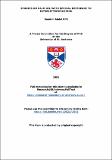Files in this item
Studies on palm oil with special reference to interestterification
Item metadata
| dc.contributor.advisor | Gunstone, F. D. | |
| dc.contributor.author | Kifli, Hamirin Abdul | |
| dc.coverage.spatial | 209 p. | en_US |
| dc.date.accessioned | 2012-07-09T14:45:33Z | |
| dc.date.available | 2012-07-09T14:45:33Z | |
| dc.date.issued | 1981 | |
| dc.identifier | uk.bl.ethos.540362 | |
| dc.identifier.uri | https://hdl.handle.net/10023/2951 | |
| dc.description.abstract | Interesterification which can be considered as the removal of fatty acids at random from glyceride molecules, the shuffling of these acids and their replacement of the glyceride molecules, has been investigated for palm oil, palm oil fractions and palm oil mixed with other vegetable oils. The reaction has been effected at 90 C in the presence o£ sodium methoxide as a catalyst. Pancreatic lipolysis has been ernployed to check the completeness of the reaction. On complete randomisation, the fatty acid composition of the 2-position is the same as that of the whole fat either before or after interestelification. The changes in the glyceride composition resulting from interesterification have been exarnined by various standard techniques. Silver ion thin layer chromatography which separates glycerides according to their degree of unsaturation has been used extensively. Using luethyl heptadecanoate as an internal standard various component glycerides have been quantified. GLG of glycerides has also been used to study the changes in glyceride composition of fats containing a wide range of fatty acid composition. The application of thin layer chromatography, using methyl heptadecanoate as an interncll standard, has also been extended to deterrnine the esters formed during interesterification when sodium methoxide is used as a catalyst. The changes in physical properties which result from interesterification have been determined by NMR (solids fat content) and DSC (thermal behaviour). Attempts to prepare a mixture of fats and oils containing palm oil and / or palm oil fractions which simulates vanaspati have been made. Many mixtures have been subjected to interesterification and the physical properties of the products have been investigated using NMR for all the mixtures and DSC of selected mixtures. The SFC curve of each mixture has been compared with that of vana spati. useful mixtures are recognised. Some potentially Stereospecific glyceride analysis of various types of palm oils has also been carried out using Brockerhoff's method. This involves partial deacylation of the triacylglycerols, isolation of the a,B-diacylglycerols, conversion of these diacylglycerols to phospholipid derivatives and finally stereospecific hydrolysis by Phospholipase A 2 from snake venom, The possible component glycerides have then been computed as suming a i-random, z- random, 3-random distribution of the fatty acids found in each of these positions. The results have been discussed in tenus of double bond number and of carbon number: The latter has been compared with results obtained by gas chromatography of the whole oil. | en_US |
| dc.language.iso | en | en_US |
| dc.publisher | University of St Andrews | |
| dc.subject.lcc | QD305.F2K5 | |
| dc.subject.lcsh | Oils and fats | en_US |
| dc.title | Studies on palm oil with special reference to interestterification | en_US |
| dc.type | Thesis | en_US |
| dc.type.qualificationlevel | Doctoral | en_US |
| dc.type.qualificationname | PhD Doctor of Philosophy | en_US |
| dc.publisher.institution | The University of St Andrews | en_US |
This item appears in the following Collection(s)
Items in the St Andrews Research Repository are protected by copyright, with all rights reserved, unless otherwise indicated.

